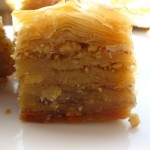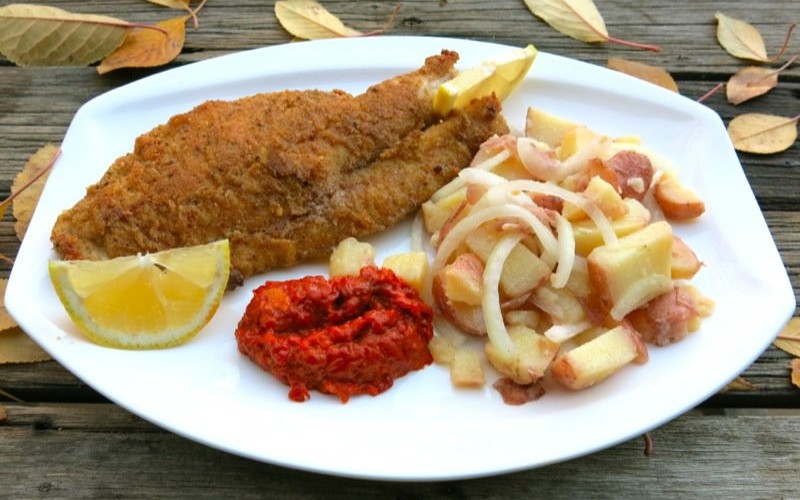Sirogojno’s Open Air Museum in Serbia
Yes, the focus of this specific blog is also on food. Food, like language and art, is a product of one’s culture, and understanding the culture is the basis for understanding the food. Visiting this open air museum of the way of life in Serbia in the 19th Century turned on more than a few light bulbs inside of my head. After visiting the remains of Kupres, the stories Petar and Pava were able to retell through our time in this open air museum brought me right back to Kupres and the past into the present. I finally got it.
Petar remembered making fences exactly like this in Kupres. They used the young pliable branches to weave in and out of the posts, and as they dried, the fence was formidable. I was enthralled. I was also really taken aback by how primitive their childhood lives were. His house in Kupres was exactly like one of the ones we stood in here. He said they were all alike.
Most Canadian farms in the 1800’s were not as rustic as these. Most of the farmers in our country in the 1800’s were immigrants and had come from a European country with some personal belongings, and were able to make a good living for themselves in this new world. In Serbia, the land was inhabited by the Slavs, and had been for thousands of years. However, the farmers were never able to make a good living for themselves for a variety of reasons:
The frescos in the old monasteries and churches bear haunting faces with eyes searching for the truth. The Serbian monasteries hold some of the world’s most prized Byzantine frescos.
Religion has been the supposed cause of the last war in Bosnia with the three sides: Serbs (Orthodox), Croats (Catholics), and Bosnians (Muslim). Somehow ethnicity got confused with religion. This has happened in many regions of the world. If you are Catholic, and live in Serbia, even if you were born there, you are considered a Croat, not a Serb. This is the same in each place: if you are Orthodox, and live in Bosnia, you are a Serb, not a Bosnian. It is strange to me. What is sadder, and stranger, is that these people are all the same race. It is a primordial position that goes back further than anyone even living here understands. And what is even stranger is that most people do not even go to church or the mosque. Many do. Most do not. However, the rituals and ceremonies that bring the families together each have a basis in religion. The Serbs celebrate their patron saint day with a Slava. The Slava is a celebration of the family’s patron saint. Each family professes literal lineage from one or another saint, and the fraternal line has celebrated this day since the beginning of time. Once you understand this, it is a very powerful tie to one’s past, and to one’s culture. Each church or mosque is a symbol of a history that has been long and hard, and that many have fought and died for.
This museum is literally a walk through history, but not through the distant past. I walked through it with two adults who lived it.
The water source was fresh and clear and tasted like liquid air. See they man made beehives? They were woven with reeds or green branches, then covered with mud and bark. Each small community would have a bee keeper.
Of course, wheat and other grains were grown and these little A-frame houses stored it.
There was always one woman in each village that took care of all of the dairy products in the village and she would be the only one allowed into the dairy making house for sanitary reasons. The large white stone on the bench was used for pressing cheese into the round shape carved within it. What looks like a butter churn was used for making kjimak, the paddles were used to skin the milk and the other containers were used to make kisela mleka (sour mild, or what we know in Canada as yogurt), and pavlaka (sour cream).
Below are the water barrels that the children would hoist up onto their shoulder and take to the water source to fill each day.
Here is the main large cooking pot that would hang in the middle of the main room of the house to do the major cooking. There would be a fire built under it, and it would be usually filled with some kind of soup or stew. The table and chairs to the right and low to the floor are exactly what both Petar and Pava remember from their childhood homes. This main room had a dirt floor. There is also another fireplace in this house which Petar said was also in his, built into the wall to heat the second room (raised with a wooden floor) for sleeping. In the lower photo to the right do you see the hole in the middle of the roof is? You lift it open like the flu of a fireplace to let the smoke out by pushing on the long stick. The big black pots are still used in the country side today on open fires to make ajvar and other major outdoor preserving. And, yes, this would be the same kind of pot that Petar sprinkled the ammunition into from his pouch when he was tired of eating gruel day after day after day. (Read about that here)
These wooden bowls were all too familiar to Petar and Pava. They used them. Petar made them. They were part of their early life. Each had a very specific purpose. The huge one to the lower left was for making bread. He couldn’t recall what the other two were for.
The paddles were for putting the bread in and out of the stone fire oven, and the little ladder on the far right was for somehow getting into the loft that some houses managed to use for storage. Petar told us how his uncle would lock his tobacco in a cabinet like the one in the middle, but Petar found a way to get into it, and stole a little regularly to give tot he Partisan soldiers as a child. His uncle never knew.
When a couple married, there would be a very tiny sleeping house made for them, but all other living would continue in the family home, and most of the day was spent working in the field, or at a specific occupation. Later, there might be a potter, as shown below, middle.
Ah, and one cannot forget the sljiva! This is such an ancient still that it was even foreign to Pava and Petar. Neither had seen one this old. But, never mind, the process is the same! It will still work and produce sljiva, and that is all that matters! The ripened plums are left to ferment on their own about three to four weeks in the huge storage containers shown on the lower right. Then, all that can fit will be put into the barrel covered with water on top of the fire on the far left of the above photo. The fire will be built beneath it and as the plums cook, steam is created, and the alcohol is in the steam. That steam goes into the tube coming out of the plum barrel and going into the huge barrel just to the right of it. If you look on the top photo on the far right, you can see inside of that big barrel. The tube goes right through that big barrel, and the barrel is filled with ice water. The ice water makes the steam condense, and the condensation comes out of the tube into the last little barrel (a close up is in the last photo on the left, above). Ta-da! This is the sljiva.
Basket weaving was also a necessity (above), and below is the blacksmith’s workshop. Can you see the massive bellows to the right at the top of the first photo stored on a shelf? And below that is an ancient combine, but not so ancient. It was still used a hundred years ago, and farmers everywhere in the Balkans still use scythes. They even have scythe competitions like we have out rodeos.
I was so excited to see the fruit drying house as I made one once using the exact premise. Layers of screens to dry the fruit with a false back that let the warm air through to dry each layer. Of course, the layers need to be moved regularly. A low fire (or two) was built in the back of this one. See the close up of the huge fruit shelves from the front?
The shape of these charming little dwellings is unique to the Balkans, and the lives lived within were hard. Life is still hard throughout most of the Balkans,
but the Slavs know how to survive: with their hands, and with their hearts.
On the way into the open air museum (or on the way out) you can buy the most gorgeous handmade sweaters and caps and slippers and mittens. Some are rustic and traditional, others are more beautiful that one would find in the finest shops on the Champs Elysee. Truly. I did not need anything, but the sweetest and most fashionable little sweater coat for a child was the equivalent of 30 Canadian dollars. I would estimate a similar piece in Canada to easily be 150 Canadian dollars. I didn’t feel it was too respectful to take photos without buying, so you will have to trust me on this.
The hand stitched and embroidered linens were hard to pass by, too!
So, I can see how hard these people worked to prepare a simple meal each day from the visit through this open air museum. I still see it now. When one works this hard, the food must be tasty, and it absolutely is. I have asked over and over this trip, “œWhy is it that so many regions of the world are famous for their food, and not the Balkans?” But, as ask, I think I have the answer. There is seemingly little variety to a visitor. Smoked cured meat, home made cheese and tomato and pepper salads. Where ever you go, it is always the same. (Lest I forget the palacinka and the sljiva!) However, as I discovered this trip, the idea is the same; the presentation is the same, but each region has their own unique way of making their cheeses and meats and their salads and pitas. Each one is delicious, and it has been such fun and so fascinating to learn this, and to develop this sense through this trip this year. And, one must celebrate the produce. It is spectacular and plentiful everywhere in the summer. The flavours and textures in the vegetables are hard to come by at home, and here, there is only the best everywhere.
I didn’t mention that you can actually stay here. This is a video from Sheila, someone who did!
http://youtu.be/RtF2tyssr1U



































































Leave a Reply